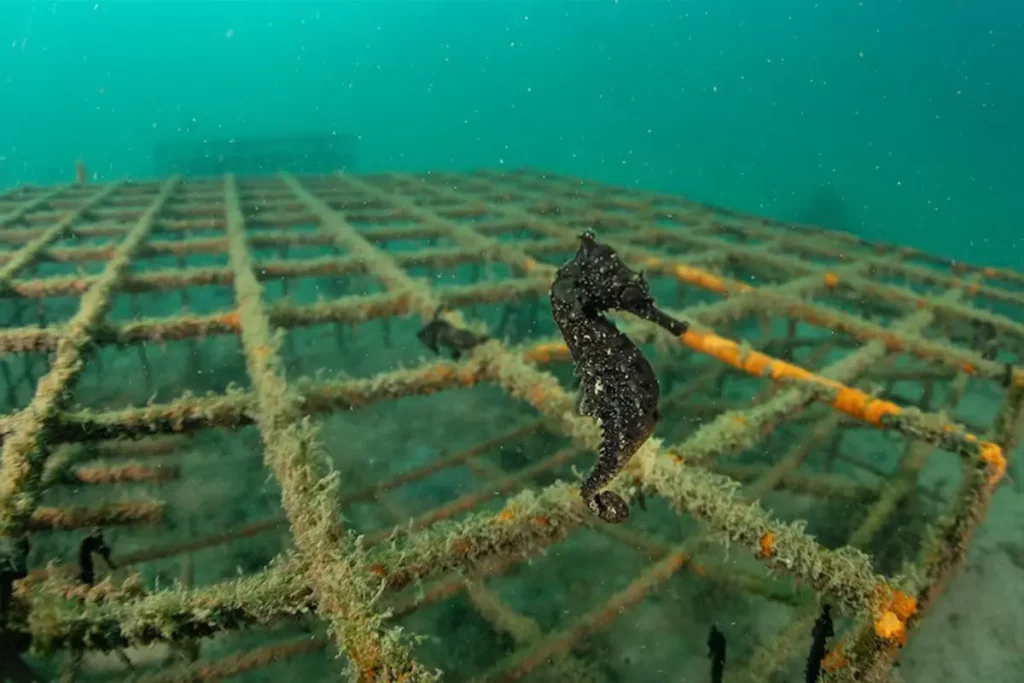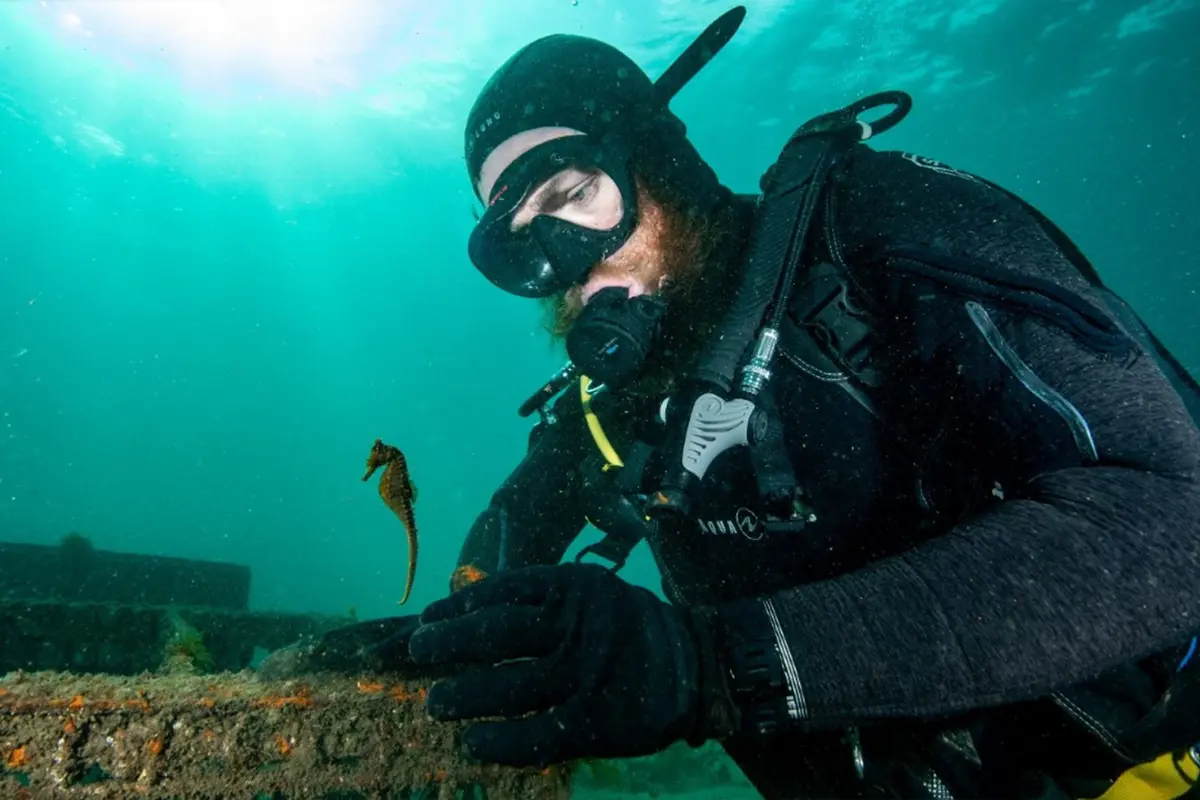‘Seahorse hotels’ are multipurpose. They give shelter, can biodegrade and encourage the growth of new coral and sponge. It is the new home of the White’s Seahorse
The White’s Seahorse is endangered. So what is being done?
In 2020, the White’s Seahorse was registered as the second most endangered species of seahorse in the world. Since then, the Sydney Seahorse Project has been working to restore their habitat and grow their population. Earlier this year, the Sydney Institute of Marine Science captured three pregnant males and helped them raise 380 babies.
Sydney – the biggest release of White Seahorses
They have just been released back into the wild. «This is the biggest release of seahorses ever undertaken in the world, and it’s of the endangered White’s seahorse», said New South Wales Fisheries scientist, David Harasti. However, their commitment doesn’t stop there. To ensure that they reintegrate in the safest and most efficient way possible, scientists have built them artificial shelters, dubbed ‘seahorse hotels’.
These buildings are made from metal with sponges growing over the structure. One of the benefits of these creations is that they gradually get covered with natural coral and sponges. Hence, repopulating a habitat with an endangered species isn’t overshadowed by unsustainable practices. In this case, the project is more rounded, taking into consideration every step in this wildlife conservation project.
The White’s Seahorse species
The White’s Seahorse, also known as Hippocampus white, used to heavily populate Sydney waters in New South Wales. It is thought to be endemic to the Southwest Pacific, staying close to Sydney, New South Wales, Queensland and the Solomon Islands. In terms of habitat, the seahorse likes to blend in with their environment as much as possible.
Therefore, a more complex habit is what they look out for. This is also due to the increase in food options and availability. In recent years, scientists found that these seahorses use artificial features as a home base. This includes shark nets and jetties. One reason for this may stem from their continued loss in natural habitat.
Between 2008 and 2015, the species halved in population in Sydney. In the New South Wales north coast, the population decreased by 95% in the same amount of time. In 2017, the International Union for Conservation of Nature (IUCN), red-listed the species as endangered. They also declared that habitat loss was the main factor in the decrease in numbers.

The Sydney Seahorse Project
The Sydney Institute of Marine Science (Sims), in partnership with Sydney’s University of Technology and the New South Wales Department of Primary Industries, runs the Sydney Seahorse Project. «The Sydney Seahorse Project aims to promote the conservation of the White’s Seahorse», said Mitchell Brennan, scientist and Project Manager. In January of this year, they collected three pregnant males. They were taken to a custom-built breeding center at SEA LIFE Sydney Aquarium. Five months later, the male seahorses give birth to about 380 babies collectively.
One of the more successful parts of the project was the survival rate during the breeding process. Seahorses typically give birth to 100 babies each. In the wild, White’s Seahorses typically have a survival rate of one percent, but the project saw that increase to almost ninety percent. This was done by increasing the water temperature to 23 degrees and feeding them brine shrimp.
«In the aquarium, we can control the environment, there’s no predators there. We’re able to raise them at quite optimal temperatures», said Brett Fenton, the general manager of Sims. «We have high expectations that we’ll see the animals thrive over the next 12 months».
The ‘seahorse hotel’ — biodegradable metal
«Habitat loss is one of the primary causes of this species being listed as endangered, so we needed to address the issue at its source. One of the ways we are doing that is by providing artificial habitats», said Brennan. These artificial creations were inspired by other man-made shelters which the seahorses had previously used — more specifically, crab nets. This year, they added eight more of these hotels in the area.
There is one detail in the design which makes these structures a long term solution to temporary shelter. Over Time, algae, sponge and coral will grow around the metal bars. The weight of these natural components will continuously increase, encouraging the artificial structure underneath to gradually collapse. Therefore, what remains is a strong habitat for the White’s Seahorse in the long-run.
These ‘seahorse hotels’ are increasingly more valuable for the aquarium-bred seahorses. Upon release, they are extremely vulnerable to predators around the area, including just a typical fish. Therefore, when divers go to bring them to their new home, they ensure that the babies are within the hotel. In this way, they are shielded from the other wildlife by the natural coral and sponge growing around the metal structures.
The future of the Sydney Seahorse Project
Now that the seahorses have been released, it does not mean that those involved will stop monitoring them. Before putting them back in the wild, each seashore was individually tagged. In this way, they can be easily identifiable when checking up on their health and progress. A monitoring program was established to assess their growth, health and breeding patterns.
Since the beginning of this project in 2019, hundreds of White’s Seahorses have been successfully bred and released. The last time this was done in the area was in 2020 in Chowder Bay within Sydney Harbor.
Regarding the survival rates of the babies, Brennan explains that they hope the successful captive breeding will translate in the wild. Releasing the babies when they are larger in size, provides them with a better chance of finding food and getting away from predators.
This way, it gives the species an opportunity to breed in larger numbers in the wild. For now, members of the project are encouraging citizen scientists to take pictures and document the seahorses when diving in Chowder Bay and submitting them to their naturalist project.
The Sydney Seahorse Project
The Sydney Seahorse Project is a collaboration between the Sydney Institute of Marine Science, the University of Technology Sydney and the New South Wales (NSW) Department of Primary Industries. Its goal is to encourage the wildlife conservation of the White’s Seahorse species. They collaborate with students and volunteers around the area with the aim of growing and expanding this project overtime. This also includes creating more ‘seahorse hotels’ to help reestablish the specie’s habitat.



















